Learning to play the guitar typically involves, well, a guitar. But what if you don’t have access to one? Can you still make progress on your musical journey? Surprisingly, the answer is yes. While you won’t be able to develop physical skills like strumming or fretting, you can cultivate the mental and emotional aspects crucial for guitar playing. This article explores three effective methods to learn guitar without a physical instrument: theoretical learning, observation, and visualization.
Deep Dive into Music Theory
A strong foundation in music theory is essential for any aspiring guitarist. Without a guitar in hand, you can fully immerse yourself in theoretical concepts. Online resources like music theory videos specifically designed for guitarists are invaluable. These allow you to delve into complex topics like scales, chords, and rhythm at your own pace, repeatedly reviewing material until it’s fully grasped. Focusing solely on the theoretical aspects can lead to a deeper understanding than trying to learn theory and practice simultaneously.
Learn by Observation: Watching Others Play
Observing experienced guitarists, whether instructors or your favorite artists, offers valuable learning opportunities. Pay close attention to their techniques: how they bend strings, their rhythmic groove, their articulation of notes, and how they interact with other musicians. Analyzing performances helps you internalize musical nuances and develop a keen ear for timing, dynamics, and phrasing. Try identifying the beat and its subdivisions. Focused listening enhances your understanding of musicality, ultimately benefiting your future practice sessions with a physical guitar.
Master the Fretboard: Mental Visualization
Visualizing the guitar fretboard is a powerful technique used by many musicians. You can achieve this by drawing a fretboard on paper and labeling the notes. Start with one note, marking its position across all strings and frets. Then, proceed to the next note, gradually building a complete mental map. This exercise strengthens your understanding of note relationships and improves fretboard navigation. Alternatively, you can use pre-printed fretboard diagrams available online. Consistent practice allows you to mentally “see” the fretboard, aiding future playing.
Unleash the Power of Visualization: Playing in Your Mind
Visualization extends beyond the fretboard to encompass entire playing sequences. Imagine yourself playing scales or chords, focusing on finger movements and the sound of each note. If you struggle, refer to written scales or chord diagrams, then resume visualizing. Combine this with auditory visualization, hearing the notes as you mentally play them. This technique, borrowed from athletes, trains your mind to execute musical ideas, bridging the gap between theory and physical practice. This mental rehearsal strengthens your musical intuition and prepares you for actual playing.
Conclusion
Learning to play guitar without a guitar might seem counterintuitive, but it’s a valuable use of time for aspiring musicians. Focusing on theory, observation, and visualization strengthens your musical foundation, preparing you for faster progress when you finally have access to an instrument. These mental exercises cultivate a deeper understanding of music, enhancing your future playing abilities. So, even without a guitar in hand, you can still take significant steps towards becoming a musician.
